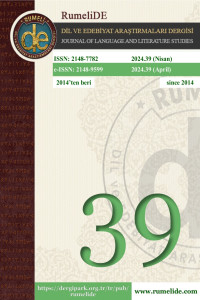Öz
Kaynakça
- Ağın, B. (2012). The agency question: Animal as the subject/object/abject in Hollywood [Paper presentation]. V Biennial Conference of EASLCE, Tenerife, Spain.
- Ağın, B. (2020). Posthümanizm: Kavram, kuram, bilim-kurgu (1st ed.). Siyasal Kitabevi.
- Bolter, J. D. (2016). Posthumanism. In K. B. Jensen, E. W. Rothenbuhler, J. D. Pooley, & R. T. Craig (Eds.), The International encyclopedia of communication theory and philosophy (pp. 1-8). https://doi.org/10.1002/9781118766804.wbiect220
- Bostrom, N. (2005a). Transhumanist values. Journal of Philosophical Research, 30(Supplement), 3-14. https://doi.org/10.5840/jpr_2005_26
- Bostrom, N. (2005b). In defense of posthuman dignity. Bioethics, 19(3), 202-214.
- Braidotti, R. (2005). Affirming the affirmative: On Nomadic affectivity. Rhizomes, 11/12. http://www.rhizomes.net/issue11/braidotti.html
- Braidotti, R. (2006). Posthuman, all too human: Towards a new process ontology. Theory, Culture & Society, 23(7-8), 197-208. https://doi.org/10.1177/0263276406069232
- Braidotti, R. (2013). The posthuman. Polity Press.
- Ceiridwen, T. (2001). Romancing the bomb: Marine animals in naval strategic defense. Organization & Environment, 14(1), 105-113. http://www.jstor.org/stable/26161717
- Doede, B. (2009). Transhumanism, technology, and the future: Posthumanity emerging or sub-humanity descending?. Appraisal, 7(3), 39-54.
- Ferrando, F. (2014). The body. In Ranisch, R. and Sorgner, S. L. (Eds.), Post- and transhumanism: An introduction (1st ed., pp. 213-226). Peter Lang. https://doi:10.3726/978-3-653-05076-9
- Haraway, D. (1991). Simians, cyborgs, and women: The reinvention of nature. Routledge.
- https://doi:10.1111/j.1467-8519.2005.00437.x
- Islam, M. (2016). Posthumanism: Through the postcolonial lens. In D. Banerji, & M. Paranjape (Eds.), Critical posthumanism and planetary futures (1st ed., pp. 115-129). Springer. https://doi.org/10.1007/978-81-322-3637-5_7
- Krishnan, A. (2016). Military neuroscience and the coming age of neurowarfare. Taylor & Francis.
- Latour, B. (2011). Love your monsters. Breakthrough Journal, 2(11), 19-26.
- Murnaghan, I. (2017, November 14). Animal tests in military defence. About Animal Testing. https://www.aboutanimaltesting.co.uk/animal-tests-military-defence.html
- Nayar, P. K. (2018). Posthumanism. John Wiley & Sons.
- Ranisch, R., & Sorgner, S. L. (Eds.). (2014). Post- and transhumanism: An introduction (1st ed, pp. 7-27). Peter Lang. https://doi:10.3726/978-3-653-05076-9
- Tchaikovsky, A. (2017). Dogs of war. Bloomsbury Publishing.
- Wolfe, C. (2003). Animal rites: American culture, the discourse of species, and posthumanist theory (1st ed.). University of Chicago Press.
- Wolfe, C. (2010). What is posthumanism?. University of Minnesota Press.
Öz
Adrian Tchaikovsky is renowned for exploring animal consciousness and non-human perspectives in his works. His 2017 novel Dogs of War exemplifies the dominance of anthropocentrism within the novel’s transhumanist context, wherein genetically engineered non-human bioforms are exploited by humans. This study argues the way humans perceive and treat non-human subjects in the novel, which are reduced to “disposable bodies” (Braidotti, 2013, p.15), extends the reach of human-centred ideology into transhumanism. Therefore, the termination of the bioforms once they are deemed obsolete demonstrates a utilitarian view of life within transhumanist thought. Building upon these arguments, this study examines whether genetically engineered non-human entities in the novel are entitled to the same rights as their human creators, who design and command them in the pursuit of technological and military advancements. By extension, this study proposes Tchaikovsky's portrayal of bioform animals resonating with Donna Haraway’s concept of the “cyborg,” which challenges the traditional concept of humans by attributing agency and sentience to these beings. The study seeks to illuminate the complex interplay between human and non-human agency, thereby questioning the established hierarchy of beings in the context of transhumanist thought.
Anahtar Kelimeler
Adrian Tchaikovsky Dogs of War Transhumanism Anthropocentrism Posthumanism.
Kaynakça
- Ağın, B. (2012). The agency question: Animal as the subject/object/abject in Hollywood [Paper presentation]. V Biennial Conference of EASLCE, Tenerife, Spain.
- Ağın, B. (2020). Posthümanizm: Kavram, kuram, bilim-kurgu (1st ed.). Siyasal Kitabevi.
- Bolter, J. D. (2016). Posthumanism. In K. B. Jensen, E. W. Rothenbuhler, J. D. Pooley, & R. T. Craig (Eds.), The International encyclopedia of communication theory and philosophy (pp. 1-8). https://doi.org/10.1002/9781118766804.wbiect220
- Bostrom, N. (2005a). Transhumanist values. Journal of Philosophical Research, 30(Supplement), 3-14. https://doi.org/10.5840/jpr_2005_26
- Bostrom, N. (2005b). In defense of posthuman dignity. Bioethics, 19(3), 202-214.
- Braidotti, R. (2005). Affirming the affirmative: On Nomadic affectivity. Rhizomes, 11/12. http://www.rhizomes.net/issue11/braidotti.html
- Braidotti, R. (2006). Posthuman, all too human: Towards a new process ontology. Theory, Culture & Society, 23(7-8), 197-208. https://doi.org/10.1177/0263276406069232
- Braidotti, R. (2013). The posthuman. Polity Press.
- Ceiridwen, T. (2001). Romancing the bomb: Marine animals in naval strategic defense. Organization & Environment, 14(1), 105-113. http://www.jstor.org/stable/26161717
- Doede, B. (2009). Transhumanism, technology, and the future: Posthumanity emerging or sub-humanity descending?. Appraisal, 7(3), 39-54.
- Ferrando, F. (2014). The body. In Ranisch, R. and Sorgner, S. L. (Eds.), Post- and transhumanism: An introduction (1st ed., pp. 213-226). Peter Lang. https://doi:10.3726/978-3-653-05076-9
- Haraway, D. (1991). Simians, cyborgs, and women: The reinvention of nature. Routledge.
- https://doi:10.1111/j.1467-8519.2005.00437.x
- Islam, M. (2016). Posthumanism: Through the postcolonial lens. In D. Banerji, & M. Paranjape (Eds.), Critical posthumanism and planetary futures (1st ed., pp. 115-129). Springer. https://doi.org/10.1007/978-81-322-3637-5_7
- Krishnan, A. (2016). Military neuroscience and the coming age of neurowarfare. Taylor & Francis.
- Latour, B. (2011). Love your monsters. Breakthrough Journal, 2(11), 19-26.
- Murnaghan, I. (2017, November 14). Animal tests in military defence. About Animal Testing. https://www.aboutanimaltesting.co.uk/animal-tests-military-defence.html
- Nayar, P. K. (2018). Posthumanism. John Wiley & Sons.
- Ranisch, R., & Sorgner, S. L. (Eds.). (2014). Post- and transhumanism: An introduction (1st ed, pp. 7-27). Peter Lang. https://doi:10.3726/978-3-653-05076-9
- Tchaikovsky, A. (2017). Dogs of war. Bloomsbury Publishing.
- Wolfe, C. (2003). Animal rites: American culture, the discourse of species, and posthumanist theory (1st ed.). University of Chicago Press.
- Wolfe, C. (2010). What is posthumanism?. University of Minnesota Press.
Ayrıntılar
| Birincil Dil | İngilizce |
|---|---|
| Konular | İngiliz ve İrlanda Dili, Edebiyatı ve Kültürü |
| Bölüm | Dünya dilleri ve edebiyatları |
| Yazarlar | |
| Yayımlanma Tarihi | 21 Nisan 2024 |
| Gönderilme Tarihi | 30 Ocak 2024 |
| Kabul Tarihi | 20 Nisan 2024 |
| Yayımlandığı Sayı | Yıl 2024 Sayı: 39 |


